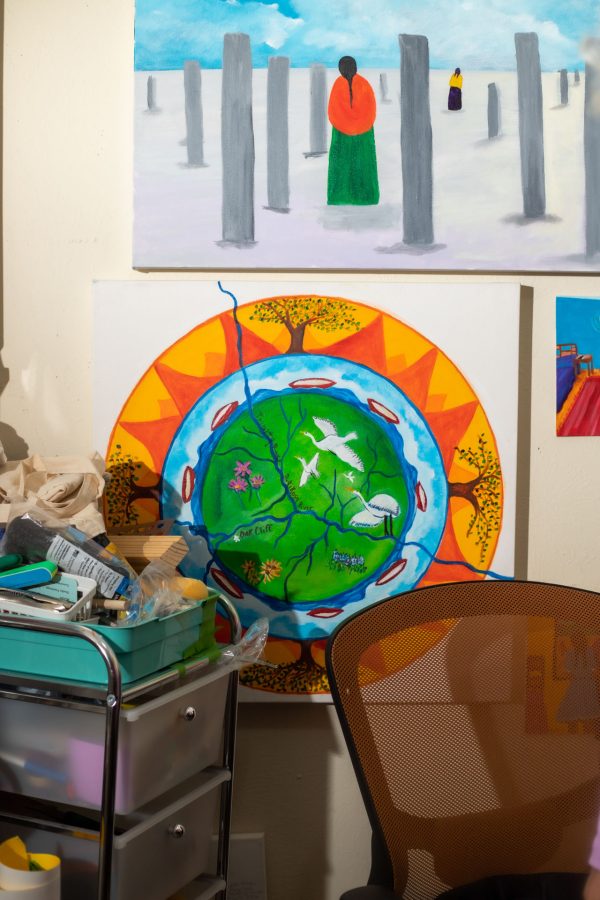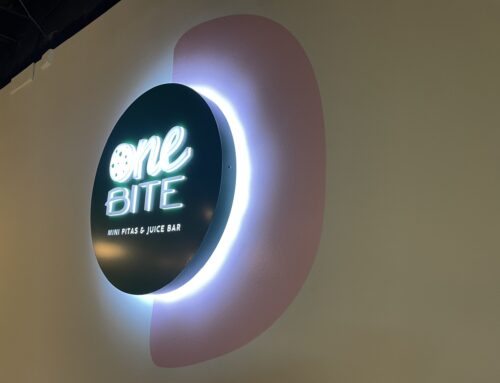
Photography by Jessica Turner.
Except for those skipping to the courthouse with a marriage license, the new Dallas County Government Building in Oak Cliff can be an unpleasant place to go. It’s where evictions are filed and truants are punished, for example.
But a little comfort is provided visually. The building is filled with natural light and comprises a gallery of Latino art, inside and out, curated by Jorje Baldor, the Dallas Housing Authority board chairman who owns Mercado369.
“Right now, things are just so hard for everybody,” artist Viola Delgado says. “If we can have art like this that reminds people of a happier time, why not?”
Delgado has three mural-size paintings on canvas in the building, featuring vibrantly colored landscapes and women wearing shawls. The paintings were supposed to be a tryptic, titled Purple Mountain Majesties, although they’re not all placed together.
“The women are the ancestors that support us and go before us and come after us,” Delgado says. “Those women just want to go everywhere,” because they keep popping up in her work, through inspiration or by request from commissions.
Delgado, who has lived in Vickery Meadow since 1998, has kept busy over the past 15 years or so creating public art for DFW International Airport and DART.
Her piece at DFW’s Terminal D, gates 8-10, is a tile mosaic inlaid to the floor depicting eight blue hands and eight infinity symbols.
“There’s something very mystical about that,” she says. “They didn’t put it at gate 8 intentionally. It was supposed to be gates 1-3 originally.”
The piece honors her father, who died before it was completed.
“He and my mom planned to travel when he retired, and then my mother got Parkinson’s, so I did all that in his honor so that he’ll always be at the airport going somewhere,” she says.
That commission also jetted her into public art. Her mosaics at DART stations include six deeply colorful mosaics at Lake June Station, installed about 10 years ago. All of those have to do with agriculture. The builder independently commissioned her to tile the station’s columns as well.
Baldor asked Delgado to create a tile mosaic depicting the Trinity River at the Oak Cliff government building.
Oak Cliff-based artist and West Dallas native Angela Faz suggested putting the river’s Caddo name, Arkikosa, in the piece.

All of Delgado’s mosaics start with paintings, and the rest is produced industrially in Cuernavaca, Mexico. A studio there makes Byzantine glass tiles using old techniques, but its computers match the colors and work out the math — how many tiles of each color are needed and where each one of thousands should be set. The result is tiles in vibrant colors that exude Delgado’s Latino culture.
When Delgado, who’s 68, started in the late 1980s, there were few spaces available to Latino artists, unlike now, she says.
“People would get tired of being invited to Cinco de Mayo and things like that,” she says. “But it didn’t matter to me, because I figured exposure of any kind was better, and I started selling small pieces through that.”
Delgado grew up in Sinton, Texas, and her family moved to Plano when she was in high school. She graduated from Dallas Baptist University and worked for Dallas ISD’s migrant education program for about seven years.
She later took art classes at El Centro, now Dallas College, and then enrolled in the Art League School in Alexandria, Virginia, where she lived with a friend, and learned printmaking. An allergy to chemicals forced her to pivot to painting.
She moved to an apartment off Matilda Street around 1987, and her next-door neighbor was artist Filberto Chapa, who died in 2019.
“A lot of writers and artists used to live all through there at that time,” she says. “We were very poor. Sometimes Filberto would pay the electric bill and I would pay the water bill, and we would just share.”
They ran extension cords between the two buildings and carried water in jugs back and forth.
“We did what it took to continue doing what we loved to do,” she says. “Now my career is taking off, but it took a lot.”
Public art commissions can take 2-5 years from start to finish.
“To be a public artist, you really have to have a lot of patience,” she says. “I listen to what they say and put visuals to their words. That’s the easiest part to do. If you just listen, they tell you what they want.”
Delgado is not represented by a gallery, but she can be contacted directly through her website.





